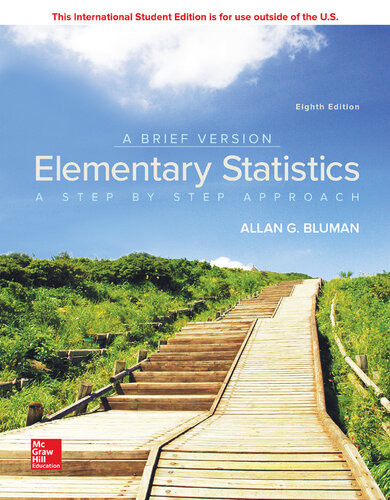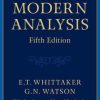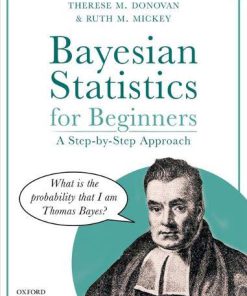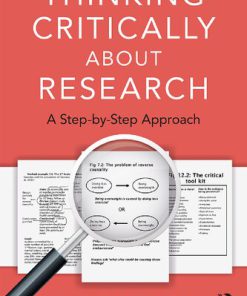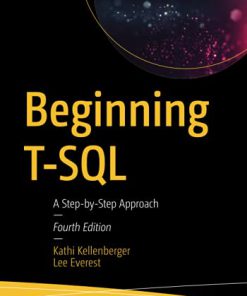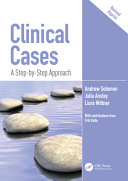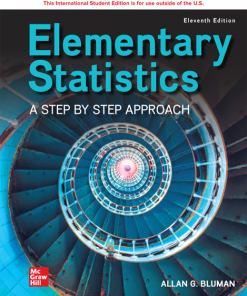ISE Elementary Statistics: A Step By Step Approach – A Brief Version, 8e 8th Edition by Allan G. Bluman 9781260387162 126038716X
$50.00 Original price was: $50.00.$25.00Current price is: $25.00.
ISE Elementary Statistics: A Step By Step Approach – A Brief Version, 8e 8th Edition Allan G. Bluman – Ebook Instant Download/Delivery ISBN(s): 9781260387162, 126038716X
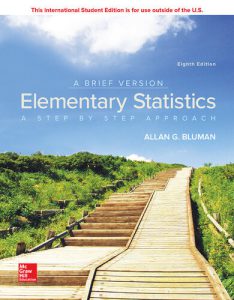
Product details:
- ISBN 10:126038716X
- ISBN 13: 9781260387162
- Author: Allan G. Bluman
Elementary Statistics: A Brief Version
Table contents:
Chapter 1 The Nature of Probability and Statistics
Introduction
1–1 Descriptive and Inferential Statistics
1–2 Variables and Types of Data
1–3 Data Collection and Sampling Techniques
Random Sampling
Systematic Sampling
Stratified Sampling
Cluster Sampling
Other Sampling Methods
1–4 Experimental Design
Observational and Experimental Studies
Uses and Misuses of Statistics
1–5 Computers and Calculators
Summary
Chapter 2 Frequency Distributions and Graphs
Introduction
2–1 Organizing Data
Categorical Frequency Distributions
Grouped Frequency Distributions
2–2 Histograms, Frequency Polygons, and Ogives
The Histogram
The Frequency Polygon
The Ogive
Relative Frequency Graphs
Distribution Shapes
2–3 Other Types of Graphs
Bar Graphs
Pareto Charts
Time Series Graphs
Pie Graphs
Dotplots
Stem and Leaf Plots
Misleading Graphs
2–4 Paired Data and Scatter Plots
Analyzing the Scatter Plot
Summary
Chapter 3 Data Description
Introduction
3–1 Measures of Central Tendency
The Mean
The Median
The Mode
The Midrange
The Weighted Mean
Distribution Shapes
3–2 Measures of Variation
Range
Population Variance and Standard Deviation
Sample Variance and Standard Deviation
Variance and Standard Deviation for Grouped Data
Coefficient of Variation
Range Rule of Thumb
Chebyshev’s Theorem
The Empirical (Normal) Rule
Linear Transformation of Data
3–3 Measures of Position
Standard Scores
Percentiles
Quartiles and Deciles
Outliers
3–4 Exploratory Data Analysis
The Five-Number Summary and Boxplots
Summary
Chapter 4 Probability and Counting Rules
Introduction
4–1 Sample Spaces and Probability
Basic Concepts
Classical Probability
Complementary Events
Empirical Probability
Law of Large Numbers
Subjective Probability
Probability and Risk Taking
4–2 The Addition Rules for Probability
4–3 The Multiplication Rules and Conditional Probability
The Multiplication Rules
Conditional Probability
Probabilities for “At Least”
4–4 Counting Rules
The Fundamental Counting Rule
Factorial Notation
Permutations
Combinations
4–5 Probability and Counting Rules
Summary
Chapter 5 Discrete Probability Distributions
Introduction
5–1 Probability Distributions
5–2 Mean, Variance, Standard Deviation, and Expectation
Mean
Variance and Standard Deviation
Expectation
5–3 The Binomial Distribution
Summary
Chapter 6 The Normal Distribution
Introduction
6–1 Normal Distributions
The Standard Normal Distribution
Finding Areas Under the Standard Normal Distribution Curve
A Normal Distribution Curve as a Probability Distribution Curve
6–2 Applications of the Normal Distribution
Finding Data Values Given Specific Probabilities
Determining Normality
6–3 The Central Limit Theorem
Distribution of Sample Means
Finite Population Correction Factor (Optional)
6–4 The Normal Approximation to the Binomial Distribution
Summary
Chapter 7 Confidence Intervals and Sample Size
Introduction
7–1 Confidence Intervals
7–2 Confidence Intervals for the Mean When σ Is Known
Sample Size
7–3 Confidence Intervals for the Mean When σ Is Unknown
7–4 Confidence Intervals and Sample Size for Proportions
Confidence Intervals
Sample Size for Proportions
7–5 Confidence Intervals for Variances and Standard Deviations
Summary
Chapter 8 Hypothesis Testing
Introduction
8–1 Steps in Hypothesis Testing—Traditional Method
P-Value Method for Hypothesis Testing
8–2 z Test for a Mean
8–3 t Test for a Mean
8–4 z Test for a Proportion
8–5 x 2 Test for a Variance or Standard Deviation
8–6 Additional Topics Regarding Hypothesis Testing
Confidence Intervals and Hypothesis Testing
Type II Error and the Power of a Test
Summary
Chapter 9 Testing the Difference Between Two Means, Two Proportions, and Two Variances
Introduction
9–1 Testing the Difference Between Two Parameters
9–2 Testing the Difference Between Two Means: Using the z Test
9–3 Testing the Difference Between Two Means of Independent Samples: Using the t Test
9–4 Testing the Difference Between Two Means: Dependent Samples
9–5 Testing the Difference Between Proportions
9–6 Testing the Difference Between Two Variances
Summary
Chapter 10 Correlation and Regression
Introduction
10–1 Correlation
10–2 Regression
Line of Best Fit
Determination of the Regression Line Equation
10–3 Coefficient of Determination and Standard Error of the Estimate
Types of Variation for the Regression Model
Residual Plots
Coefficient of Determination
Standard Error of the Estimate
Prediction Interval
Summary
Chapter 11 Chi-Square and Analysis of Variance (ANOVA)
Introduction
11–1 Test for Goodness of Fit
Test of Normality (Optional)
11–2 Tests Using Contingency Tables
Test for Independence
Test for Homogeneity of Proportions
11–3 Analysis of Variance (ANOVA)
People also search:
ise elementary statistics: a step by step approach
elementary statistics a step by step approach is
elementary statistics a step by step approach answers
what is elementary statistical methods
is elementary statistical methods the same as statistics
You may also like…
Mathematics - Mathematical Statistics
Bayesian Statistics for Beginners A Step by Step Approach Therese M. Donovan
Business & Economics - Sales & Marketing
Strategic Marketing Planning: A Step-by-Step Approach 2nd Edition Karel Jan Alsem
Uncategorized
Reference - Other Reference By Subject
Thinking Critically about Research A Step by Step Approach 1st Edition Jane Ogden
Computers - Programming
Beginning T-SQL: A Step-By-Step Approach 4th Edition by Kathi Kellenberger 9781484266069 1484266064
Medicine - Clinical Medicine
Mathematics - Mathematical Statistics
Elementary Statistics: A Step By Step Approach, 11th Edition Allan Bluman
Medicine - Surgery
Mathematics - Mathematical Statistics
Elementary Statistics: Picturing the World, 8e 8th Edition Ron Larson

